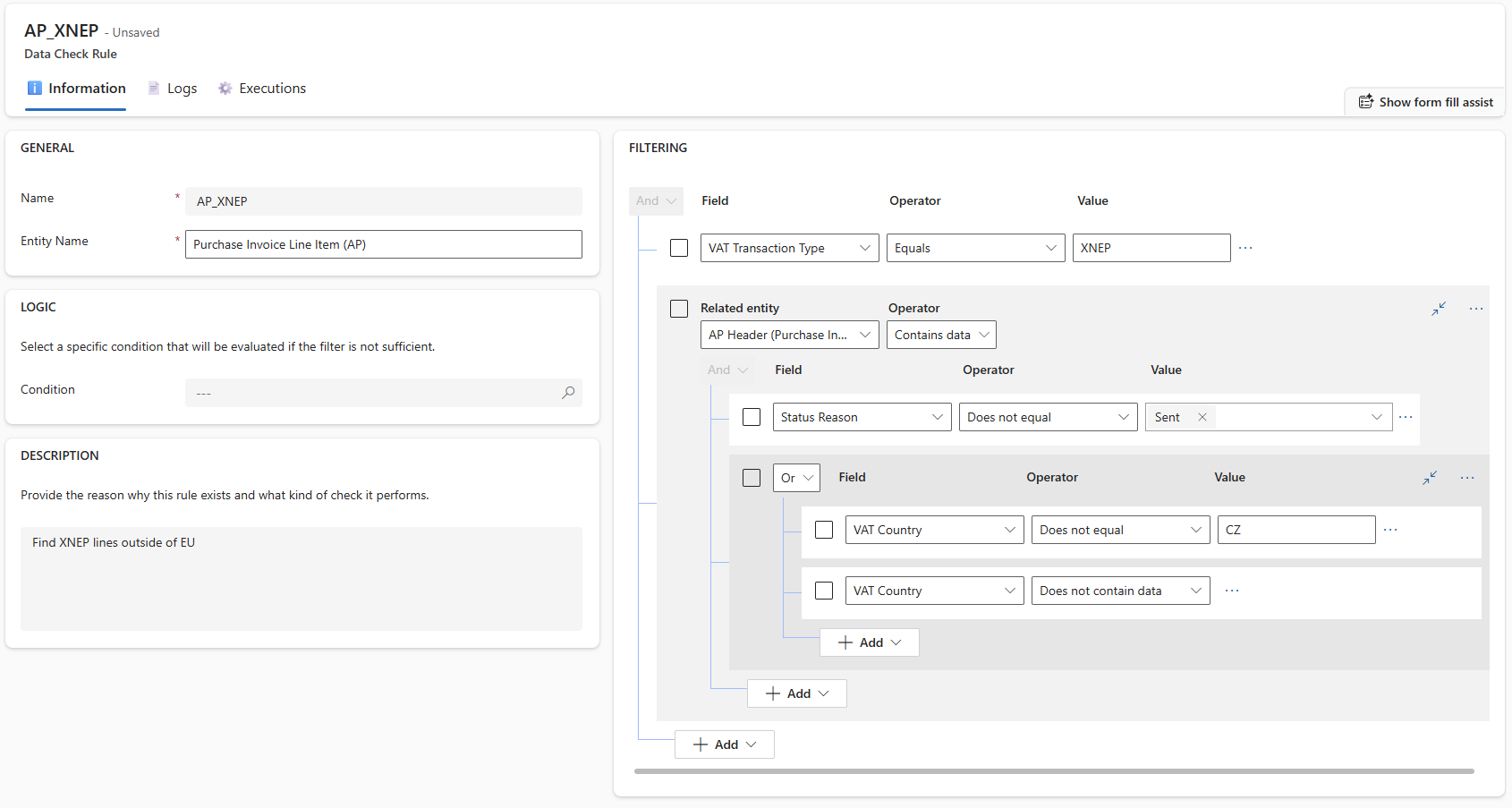Data Check Rules
# Introduction
Data Check Rules allow administrators to identify records that do not comply with expected data quality criteria. Each rule specifies a target entity, a query to identify records of interest, and an optional condition for advanced validation logic.
When a rule is executed, it generates a set of log records representing failed validations. These logs can be reviewed, manually resolved, or serve as the basis for further automated actions.

# Entity Definitions
# Data Check Rule (talxis_datacheckrule)
| Display Name | Logical Name | Description |
|---|---|---|
| Name | talxis_name | Name of the rule, typically includes its purpose or target field. |
| Entity Name | talxis_entityname | Logical name of the entity to which the rule applies. |
| Filter Query | talxis_query | FetchXML query identifying relevant records. |
| Condition (Function) | talxis_conditionid | Optional reference to a PowerFx-based function used for more advanced logic. |
| Description | talxis_description | Optional explanation of what the rule validates or checks. |
# Data Check Log (talxis_datachecklog)
| Display Name | Logical Name | Description |
|---|---|---|
| Data Record | talxis_datarecordid | Polymorphic lookup to the affected record. |
| Data Check Rule | talxis_ruleid | Reference to the rule that created this log. |
| Status (Reason) | statuscode | Current processing status (see table below). |
# Status Values
| Code | Status Name | Meaning |
|---|---|---|
| 742070000 | Evaluation | Awaiting result of condition evaluation. |
| 742070001 | Pending | Condition passed or not defined, needs user attention. |
| 742070002 | Checked | Confirmed by user, optionally after manual correction. |
| 742070003 | Cancelled | Condition evaluated to false. |
| 742070004 | Error | Error occurred during evaluation. |
# Rule Execution
Rules can be triggered in two ways:
# 1. Automatically
- As part of a broader processing pipeline (e.g., after data import).
- System filters rules by entity name and runs them on newly imported data.
⚠️ This applies only to Albert VAT App. See User Guide (opens new window) to get more info.
# 2. Manually
- Rules can be run on demand from the admin UI.
- The "Run Rule" button is available in the grid view of active rules.
Each rule execution creates one or more log entries in talxis_datachecklog, depending on the number of matching records.
# PowerFx Conditions
Rules may include an optional condition defined in a PowerFx-based Custom API (a Function). This enables scenarios that FetchXML cannot support, such as:
- Calculations
- Multi-entity logic
- Value comparisons
# Requirements
- Input:
RecordId(string) - Output:
Result(boolean)
Example function body:
{
Result:
LookUp('Invoice Lines','Line ID' = GUID(RecordId)).Amount > 1000
}
2
3
4
If the condition returns true, a log entry is marked for review.
If false, the statuscode is set to cancelled.
# Manual Resolution
Users can resolve check logs via the following options:
- Mark as Checked: Indicates that the data is acceptable despite the check failure.
- Perform Correction: Launches a dialog to apply a correction directly to the source record. This creates a related Data Transformation Log.
# Related Plugins
- ValidateCustomApiCondition – When a check rule includes a condition, this plugin executes the corresponding Function and updates the log status.
# Automation Integration
Data Check Rules can be used as part of larger workflows. Typical integration points include:
- Post-import validation
- Pre-submission data quality assurance
- Audit trail creation
Each check log entry provides a clear indication of where data failed to meet defined criteria, enabling both reactive and preventive data governance.

